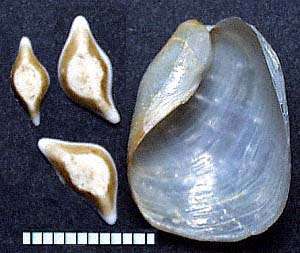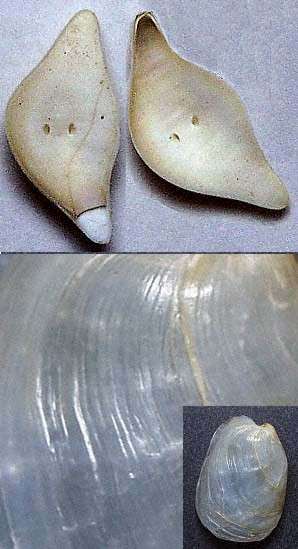
Philine orientalis?
A. Adams, 1854
Order: CEPHALASPIDEA
Family: Philinidae
DISTRIBUTION
This species has recently appeared in California. It is possibly Philine orientalis which is found naturally in Japan and southern China.
PHOTO
Shell and gizzard plates of a specimen from Bodega Bay, California, July 1998. Collected by Michelle Chow.
PHOTO: Bill Rudman.
RELATED TOPIC
Reference:
• Adams, A. (1854) Descriptions of some new species of Lophocercidae and Philinidae, from the Cumingian Collection. Proceedings of the Zoological Society, 22: 94-95.
Rudman, W.B., 1998 (July 30) Philine orientalis? A. Adams, 1854. [In] Sea Slug Forum. Australian Museum, Sydney. Available from http://www.seaslugforum.net/find/philori
Related messages
Radula of Californian Philine orientalis
August 10, 1998
From: Bill Rudman

Here are some SEM photos of the radula. They are very similar to those of the Hong Kong species I have tentatively identifed as Philine orientalis but in that species the denticles are not arranged in a uniform comb-like pattern as here in the Californian specimens. .. Bill Rudman.
UPPER: Whole tooth showing denticles along the edge of the tooth.
LOWER: magnified view of denticles.
PHOTOS: Alison Miller.
On Philine orientalis ? from California
July 30, 1998
From: Bill Rudman

This is one of two species which have appeared in large numbers in California in the last few years. I have compared the two species and discussed their relationship with
Philine auriformis elsewhere in the Sea Slug Forum.
I have referred to this species, which may be Philine orientalis, as Species 1. Its main distinguishing features are:
Gizzard plates relatively large. Two are mirror images of each other and the third, which is slightly smaller, is symmetrical in shape. The plates are flattened on the outside and have a pair of deep pin holes in the centre of the plate. The radular formula is 1.0.1, the teeth being large and hook-like with a denticulate inner edge. The penis has a long tangled tubular prostate gland filling much of the anterior body cavity beneath the foregut. The shell is smooth with no sign of sculpture. It has similarities to Philine angasi, in radula, gizzard plate and penis structure, but the shell is more constricted. One major difference is the relative size of the shell and gizzard plates, almost equal in length in Philine angasi, but in this species the larger plates are only about one half the length of the shell.
SPECIES 1 belongs to a group of species which includes Philine angasi, from New Zealand and southern Australia, and Philine aperta from Europe, with two large mirror image gizzard plates and a third smaller plate. A third species in that group, Philine orientalis A. Adams, 1854, occurs in Japan and has been recently described from Hong Kong (Morton & Chiu, 1990). The shape of the teeth and the gizzard plates in that description are very similar to those of the Californian Species 1. A species Philine kurodai Habe, 1946, which is now considered a synonym of Philine orientalis has a smooth constricted shell just like the Californian animal. Although it would need a proper comparison with Japanese material, my guess is that Species 1 is probably Philine orientalis from Japan and China. If it is this species, Morton & Chiu (1990) has some interesting information on the feeding biology of it in Hong Kong.
The photos alongside, from a specimen collected by Michelle Chow in Bodega Bay, California, July 1998, show the "pin holes" in the outer side of the two large gizzard plates, the smooth shell without any sculpture, and a view of a whole shell showing the constriction or narrowing in the posterior (upper) part of the shell. PHOTOS: Bill Rudman.
Habe, T., 1950. Philinidae in Japan. In: Illustrated Catalogue of Japanese Shells (Ed. by T.Kuroda), 7: 48-52.
Morton, B. & Chiu, S.T., 1990. The diet, prey size and consumption of Philine orientalis (Opisthobranchia: Philinidae) in Hong Kong. Journal of Molluscan Studies, 56: 289-299.
Bill Rudman
Rudman, W.B., 1998 (Jul 30). Comment on On Philine orientalis ? from California by Bill Rudman. [Message in] Sea Slug Forum. Australian Museum, Sydney. Available from http://www.seaslugforum.net/find/178